airbag MERCEDES-BENZ A-CLASS HATCHBACK 2008 Owners Manual
[x] Cancel search | Manufacturer: MERCEDES-BENZ, Model Year: 2008, Model line: A-CLASS HATCHBACK, Model: MERCEDES-BENZ A-CLASS HATCHBACK 2008Pages: 305, PDF Size: 5.43 MB
Page 6 of 305
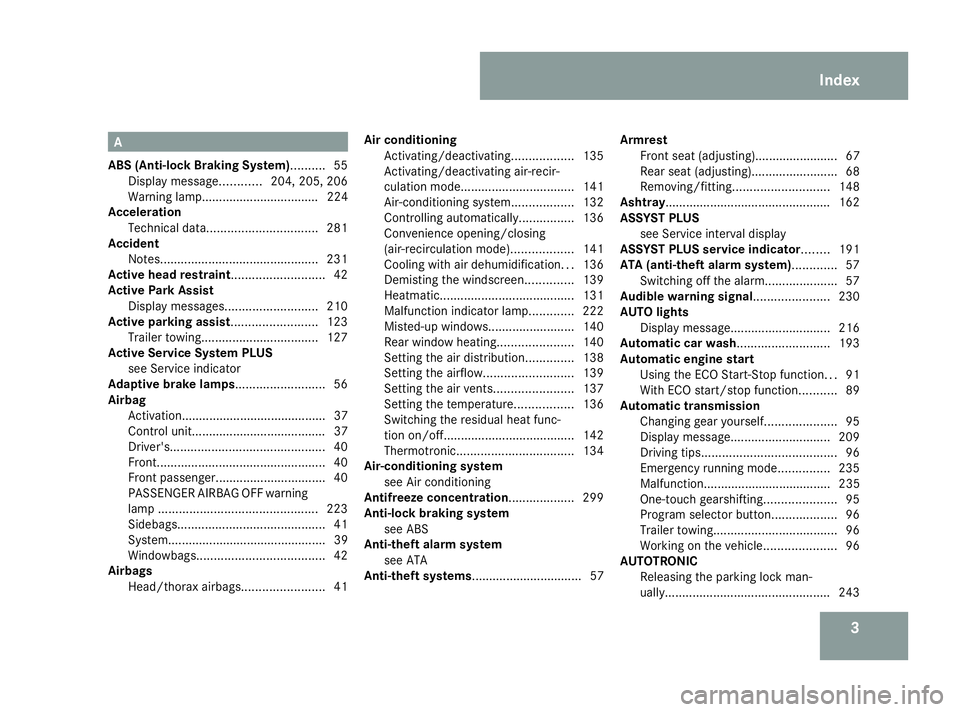
3A
ABS (Anti-lock Braking System).......... 55
Display message ............204, 205, 206
Warning lamp.................................. 224
Acceleration
Technical data. ............................... 281
Accident
Notes. ............................................. 231
Active head restraint........................... 42
Active Park Assist Display messages ........................... 210
Active parking assist......................... 123
Trailer towing. ................................. 127
Active Service System PLUS
see Service indicator
Adaptive brake lamps.......................... 56
Airbag Activation.......................................... 37
Control unit....................................... 37
Driver's ............................................. 40
Front. ................................................ 40
Front passenger ................................ 40
PASSENGER AIRBAG OFF warning
lamp .............................................. 223
Sidebags. .......................................... 41
System.............................................. 39
Windowbags. .................................... 42
Airbags
Head/thorax airbags. .......................41Air conditioning
Activating/deactivating ..................135
Activating/deactivating air-recir-
culation mode. ................................ 141
Air-conditioning system ..................132
Controlling automatically. ...............136
Convenience opening/closing
(air-recirculation mode). .................141
Cooling with air dehumidification ...136
Demisting the windscreen ..............139
Heatmatic. ...................................... 131
Malfunction indicator lamp. ............222
Misted-up windows. ........................140
Rear window heating ......................140
Setting the air distribution. .............138
Setting the airflow .......................... 139
Setting the air vents .......................137
Setting the temperature .................136
Switching the residual heat func-
tion on/off ...................................... 142
Thermotronic .................................. 134
Air-conditioning system
see Air conditioning
Antifreeze concentration................... 299
Anti-lock braking system see ABS
Anti-theft alarm system
see ATA
Anti-theft systems................................ 57 Armrest
Front seat (adjusting)........................ 67
Rear seat (adjusting).. .......................68
Removing/fitting. ........................... 148
Ashtray................................................ 162
ASSYST PLUS see Service interval display
ASSYST PLUS service indicator........ 191
ATA (anti-theft alarm system)............. 57
Switching off the alarm. ....................57
Audible warning signal...................... 230
AUTO lights Display message ............................. 216
Automatic car wash........................... 193
Automatic engine start Using the ECO Start-Stop function ...91
With ECO start/stop function ...........89
Automatic transmission
Changing gear yoursel f..................... 95
Display message ............................. 209
Driving tips ....................................... 96
Emergency running mode ...............235
Malfunction..................................... 235
One-touch gearshifting. ....................95
Program selector button ...................96
Trailer towing. ................................... 96
Working on the vehicle .....................96
AUTOTRONIC
Releasing the parking lock man-
ually. ............................................... 243 Index
169_AKB; 2; 4, en-GB
wdomann,
Version: 2.10.6 2008-07-16T08:52:06+02:00 - Seite 3Dateiname: 6515_0315_02_buchblock.pdf; preflight
Page 8 of 305
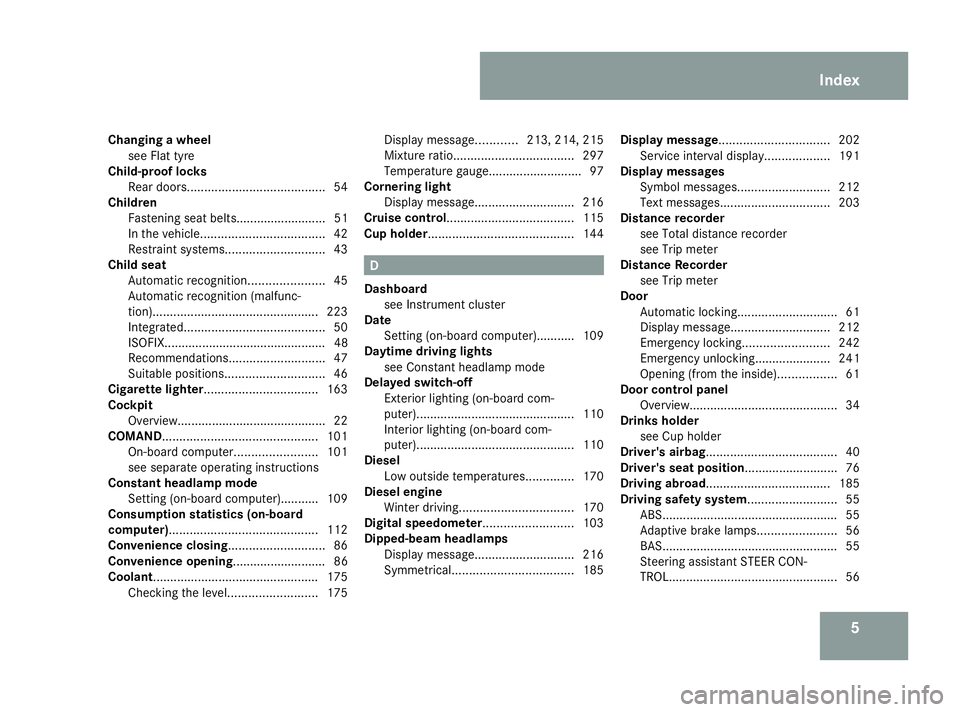
5
Changing a wheel
see Flat tyre
Child-proof locks
Rear doors ........................................ 54
Children
Fastening seat belts.......................... 51
In the vehicle. ................................... 42
Restraint systems. ............................ 43
Child seat
Automatic recognition ......................45
Automatic recognition (malfunc-
tion). ............................................... 223
Integrated ......................................... 50
ISOFIX............................................... 48
Recommendations. ...........................47
Suitable positions. ............................ 46
Cigarette lighter................................. 163
Cockpit Overview. .......................................... 22
COMAND............................................. 101
On-board computer. .......................101
see separate operating instructions
Constant headlamp mode
Setting (on-board computer).......... .109
Consumption statistics (on-board
computer)........................................... 112
Convenience closing............................ 86
Convenience opening........................... 86
Coolant................................................ 175
Checking the level. .........................175Display message
............213, 214, 215
Mixture ratio ................................... 297
Temperature gauge ...........................97
Cornering light
Display message ............................. 216
Cruise control..................................... 115
Cup holder.......................................... 144 D
Dashboard see Instrument cluster
Date
Setting (on-board computer).......... .109
Daytime driving lights
see Constant headlamp mode
Delayed switch-off
Exterior lighting (on-board com-
puter). ............................................. 110
Interior lighting (on-board com-
puter). ............................................. 110
Diesel
Low outside temperatures. .............170
Diesel engine
Winter driving. ................................ 170
Digital speedometer.......................... 103
Dipped-beam headlamps Display message ............................. 216
Symmetrical. .................................. 185Display message
................................ 202
Service interval display. ..................191
Display messages
Symbol messages. ..........................212
Text messages. ............................... 203
Distance recorder
see Total distance recorder
see Trip meter
Distance Recorder
see Trip meter
Door
Automatic locking ............................. 61
Display message ............................. 212
Emergency locking .........................242
Emergency unlocking...................... 241
Opening (from the inside). ................61
Door control panel
Overview. .......................................... 34
Drinks holder
see Cup holder
Driver's airbag...................................... 40
Driver's seat position........................... 76
Driving abroad.................................... 185
Driving safety system.......................... 55
ABS. .................................................. 55
Adaptive brake lamps. ......................56
BAS. .................................................. 55
Steering assistant STEER CON-
TROL. ................................................ 56 Index
169_AKB; 2; 4, en-GB
wdomann,
Version: 2.10.6 2008-07-16T08:52:06+02:00 - Seite 5Dateiname: 6515_0315_02_buchblock.pdf; preflight
Page 10 of 305
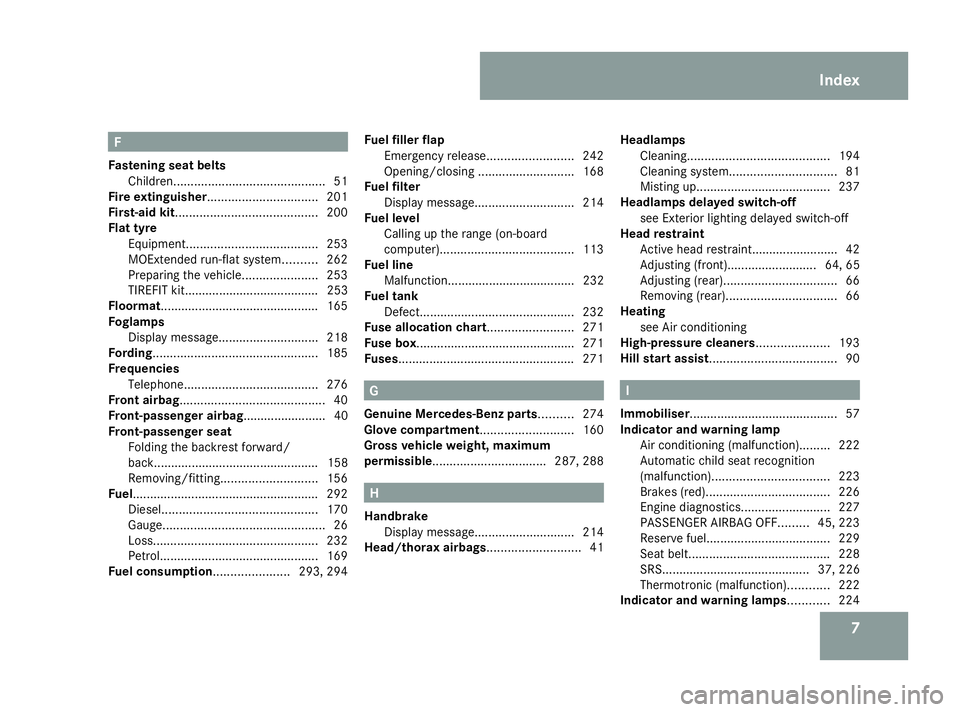
7F
Fastening seat belts Childre n............................................ 51
Fire extinguisher................................ 201
First-aid kit......................................... 200
Flat tyre Equipment. ..................................... 253
MOExtended run-flat system ..........262
Preparing the vehicle. .....................253
TIREFIT kit....................................... 253
Floormat............................................. .165
Foglamps Display message ............................. 218
Fording................................................ 185
Frequencies Telephone. ...................................... 276
Front airbag .......................................... 40
Front-passenger airbag........................ 40
Front-passenger seat Folding the backrest forward/
back................................................ 158
Removing/fitting. ........................... 156
Fuel...................................................... 292
Diesel. ............................................ 170
Gauge. .............................................. 26
Loss. ............................................... 232
Petrol .............................................. 169
Fuel consumption...................... 293, 294Fuel filler flap
Emergency release. ........................242
Opening/closing ............................ 168
Fuel filter
Display message ............................. 214
Fuel level
Calling up the range (on-board
computer). ...................................... 113
Fuel line
Malfunction..................................... 232
Fuel tank
Defect ............................................. 232
Fuse allocation chart......................... 271
Fuse box............................................. .271
Fuses................................................... 271 G
Genuine Mercedes-Benz parts.......... 274
Glove compartment........................... 160
Gross vehicle weight, maximum
permissible................................. 287, 288 H
Handbrake Display message ............................. 214
Head/thorax airbags........................... 41Headlamps
Cleaning. ........................................ 194
Cleaning system. .............................. 81
Misting up. ...................................... 237
Headlamps delayed switch-off
see Exterior lighting delayed switch-off
Head restraint
Active head restraint......................... 42
Adjusting (front).......................... 64, 65
Adjusting (rear). ................................ 66
Removing (rear). ............................... 66
Heating
see Air conditioning
High-pressure cleaners..................... 193
Hill start assist..................................... 90 I
Immobiliser........................................... 57
Indicator and warning lamp Air conditioning (malfunction) .........222
Automatic child seat recognition
(malfunction). ................................. 223
Brakes (red). ................................... 226
Engine diagnostics ..........................227
PASSENGER AIRBAG OFF .........45, 223
Reserve fuel. ................................... 229
Seat belt. ........................................ 228
SRS........................................... 37, 226
Thermotronic (malfunction) ............222
Indicator and warning lamps............ 224 Index
169_AKB; 2; 4, en-GB
wdomann,
Version: 2.10.6 2008-07-16T08:52:06+02:00 - Seite 7Dateiname: 6515_0315_02_buchblock.pdf; preflight
Page 13 of 305
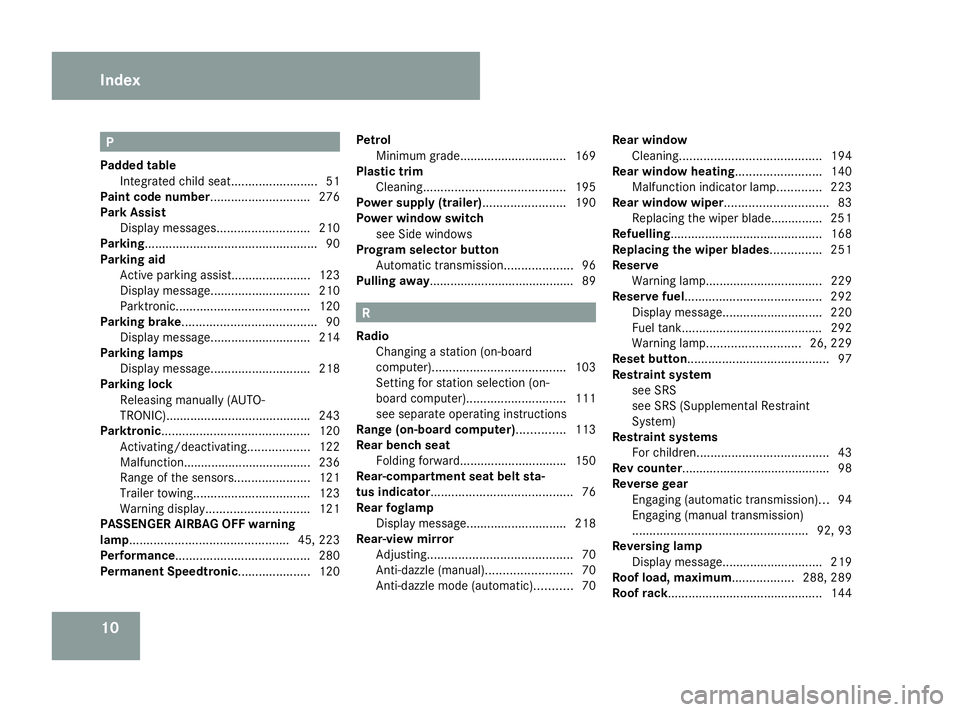
10 P
Padded table Integrated child seat. ........................51
Paint code number............................. 276
Park Assist Display messages ........................... 210
Parking .................................................. 90
Parking aid Active parking assist. ......................123
Display message ............................. 210
Parktronic. ...................................... 120
Parking brake....................................... 90
Display message ............................. 214
Parking lamps
Display message ............................. 218
Parking lock
Releasing manually (AUTO-
TRONIC)......................................... .243
Parktronic........................................... 120
Activating/deactivating ..................122
Malfunction..................................... 236
Range of the sensors. .....................121
Trailer towing. ................................. 123
Warning displa y.............................. 121
PASSENGER AIRBAG OFF warning
lamp.............................................. 45, 223
Performance....................................... 280
Permanent Speedtronic .....................120Petrol
Minimum grade............................... 169
Plastic trim
Cleaning. ........................................ 195
Power supply (trailer)........................ 190
Power window switch see Side windows
Program selector button
Automatic transmission ....................96
Pulling away.......................................... 89 R
Radio Changing a station (on-board
computer). ...................................... 103
Setting for station selection (on-
board computer). ............................ 111
see separate operating instructions
Range (on-board computer).............. 113
Rear bench seat Folding forward.............................. .150
Rear-compartment seat belt sta-
tus indicator......................................... 76
Rear foglamp Display message ............................. 218
Rear-view mirror
Adjusting .......................................... 70
Anti-dazzle (manual). ........................70
Anti-dazzle mode (automatic). ..........70Rear window
Cleaning. ........................................ 194
Rear window heating .........................140
Malfunction indicator lamp. ............223
Rear window wiper.............................. 83
Replacing the wiper blade.............. .251
Refuelling............................................ 168
Replacing the wiper blades ...............251
Reserve Warning lamp.................................. 229
Reserve fuel........................................ 292
Display message ............................. 220
Fuel tank......................................... 292
Warning lamp. .......................... 26, 229
Reset button......................................... 97
Restraint system see SRS
see SRS (Supplemental Restraint
System)
Restraint systems
For children. ..................................... 43
Rev counter........................................... 98
Reverse gear
Engaging (automatic transmission) ...94
Engaging (manual transmission)
................................................... 92, 93
Reversing lamp
Display message ............................. 219
Roof load, maximum.................. 288, 289
Roof rack............................................. 144Index
169_AKB; 2; 4, en-GB
wdomann,
Version: 2.10.6
2008-07-16T08:52:06+02:00 - Seite 10 Dateiname: 6515_0315_02_buchblock.pdf; preflight
Page 34 of 305
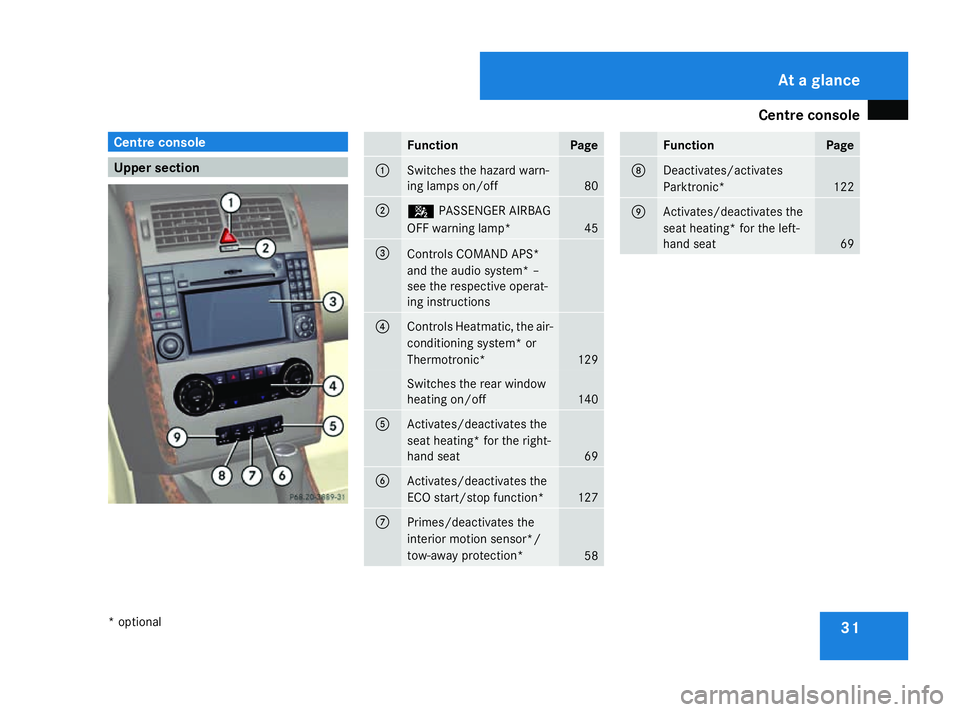
Centre console
31Centre console
Upper section Function Page
1
Switches the hazard warn-
ing lamps on/off
80
2
5
PASSENGER AIRBAG
OFF warning lamp* 45
3
Controls COMAND APS*
and the audio system* –
see the respective operat-
ing instructions
4
Controls Heatmatic, the air-
conditioning system* or
Thermotronic*
129
Switches the rear window
heating on/off
140
5
Activates/deactivates the
seat heating* for the right-
hand seat
69
6
Activates/deactivates the
ECO start/stop function*
127
7
Primes/deactivates the
interior motion sensor*/
tow-away protection*
58 Function Page
8
Deactivates/activates
Parktronic*
122
9
Activates/deactivates the
seat heating* for the left-
hand seat
69At a glance
* optional
169_AKB; 2; 4, en-GB
wdomann,
Version: 2.10.6 2008-07-16T08:52:06+02:00 - Seite 31Dateiname: 6515_0315_02_buchblock.pdf; preflight
Page 39 of 305
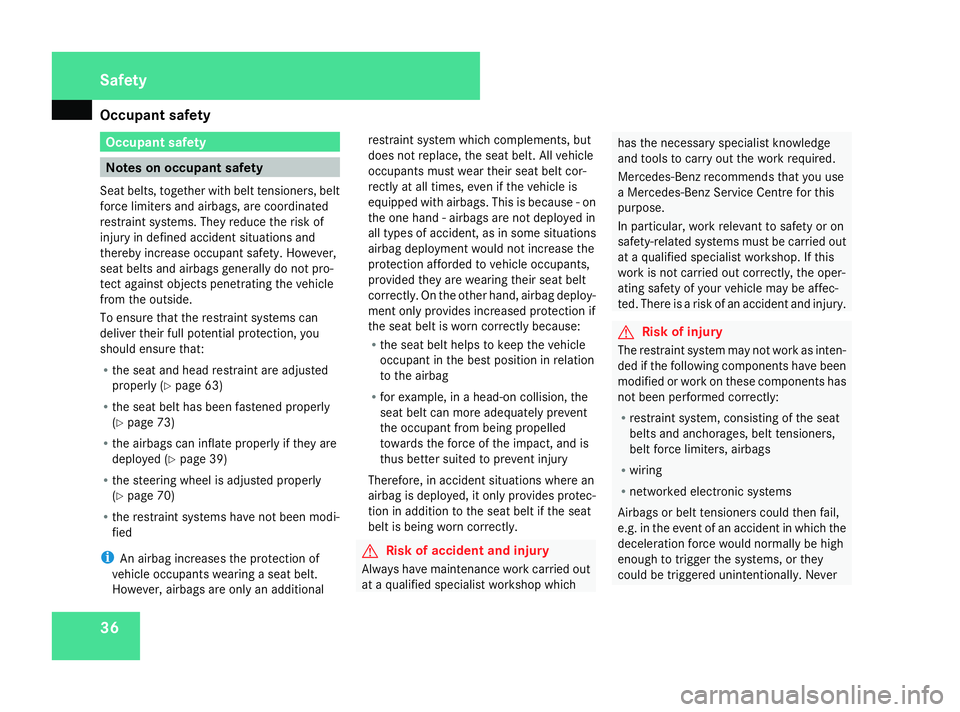
Occupant safety
36 Occupant safety
Notes on occupant safety
Seat belts, together with belt tensioners, belt
force limiters and airbags, are coordinated
restraint systems. They reduce the risk of
injury in defined accident situations and
thereby increase occupant safety. However,
seat belts and airbags generally do not pro-
tect against objects penetrating the vehicle
from the outside.
To ensure that the restraint systems can
deliver their full potential protection, you
should ensure that:
R the seat and head restraint are adjusted
properly (Y page 63)
R the seat belt has been fastened properly
(Y page 73)
R the airbags can inflate properly if they are
deployed (Y page 39)
R the steering wheel is adjusted properly
(Y page 70)
R the restraint systems have not been modi-
fied
i An airbag increases the protection of
vehicle occupants wearing a seat belt.
However, airbags are only an additional restraint system which complements, but
does not replace, the seat belt. All vehicle
occupants must wear their seat belt cor-
rectly at all times, even if the vehicle is
equipped with airbags. This is because - on
the one hand - airbags are not deployed in
all types of accident, as in some situations
airbag deployment would not increase the
protection afforded to vehicle occupants,
provided they are wearing their seat belt
correctly. On the other hand, airbag deploy-
ment only provides increased protection if
the seat belt is worn correctly because:
R
the seat belt helps to keep the vehicle
occupant in the best position in relation
to the airbag
R for example, in a head-on collision, the
seat belt can more adequately prevent
the occupant from being propelled
towards the force of the impact, and is
thus better suited to prevent injury
Therefore, in accident situations where an
airbag is deployed, it only provides protec-
tion in addition to the seat belt if the seat
belt is being worn correctly. G
Risk of accident and injury
Always have maintenance work carried out
at a qualified specialist workshop which has the necessary specialist knowledge
and tools to carry out the work required.
Mercedes-Benz recommends that you use
a Mercedes-Benz Service Centre for this
purpose.
In particular, work relevant to safety or on
safety-related systems must be carried out
at a qualified specialist workshop. If this
work is not carried out correctly, the oper-
ating safety of your vehicle may be affec-
ted. There is a risk of an accident and injury.
G
Risk of injury
The restraint system may not work as inten-
ded if the following components have been
modified or work on these components has
not been performed correctly:
R restraint system, consisting of the seat
belts and anchorages, belt tensioners,
belt force limiters, airbags
R wiring
R networked electronic systems
Airbags or belt tensioners could then fail,
e.g. in the event of an accident in which the
deceleration force would normally be high
enough to trigger the systems, or they
could be triggered unintentionally. Never Safety
169_AKB; 2; 4, en-GB
wdomann
,V ersion: 2.10.6
2008-07-16T08:52:06+02:00 - Seite 36 Dateiname: 6515_0315_02_buchblock.pdf; preflight
Page 40 of 305
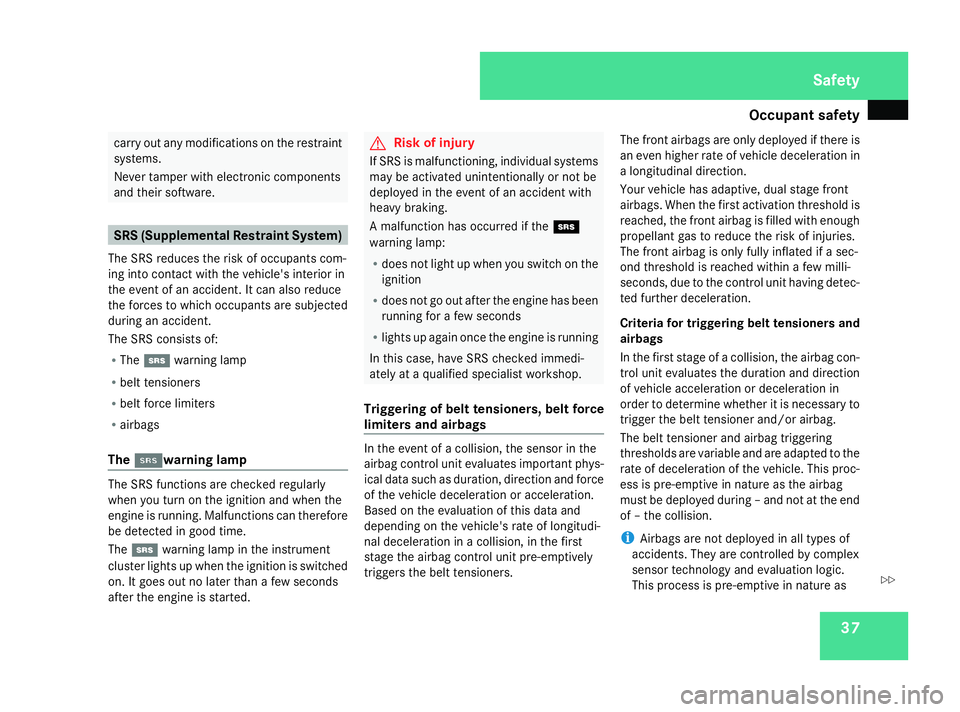
Occupant safety
37carry out any modifications on the restraint
systems.
Never tamper with electronic components
and their software.
SRS (Supplemental Restraint System)
The SRS reduces the risk of occupants com-
ing into contact with the vehicle's interior in
the event of an accident. It can also reduce
the forces to which occupants are subjected
during an accident.
The SRS consists of:
R The 1 warning lamp
R belt tensioners
R belt force limiters
R airbags
The 1 1warning lamp The SRS functions are checked regularly
when you turn on the ignition and when the
engine is running. Malfunctions can therefore
be detected in good time.
The
1 warning lamp in the instrument
cluster lights up when the ignition is switched
on. It goes out no later than a few seconds
after the engine is started. G
Risk of injury
If SRS is malfunctioning, individual systems
may be activated unintentionally or not be
deployed in the event of an accident with
heavy braking.
A malfunction has occurred if the 1
warning lamp:
R does not light up when you switch on the
ignition
R does not go out after the engine has been
running for a few seconds
R lights up again once the engine is running
In this case, have SRS checked immedi-
ately at a qualified specialist workshop.
Triggering of belt tensioners, belt force
limiters and airbags In the event of a collision, the sensor in the
airbag control unit evaluates important phys-
ical data such as duration, direction and force
of the vehicle deceleration or acceleration.
Based on the evaluation of this data and
depending on the vehicle's rate of longitudi-
nal deceleration in a collision, in the first
stage the airbag control unit pre-emptively
triggers the belt tensioners.The front airbags are only deployed if there is
an even higher rate of vehicle deceleration in
a longitudinal direction.
Your vehicle has adaptive, dual stage front
airbags. When the first activation threshold is
reached, the front airbag is filled with enough
propellant gas to reduce the risk of injuries.
The front airbag is only fully inflated if a sec-
ond threshold is reached within a few milli-
seconds, due to the control unit having detec-
ted further deceleration.
Criteria for triggering belt tensioners and
airbags
In the first stage of a collision, the airbag con-
trol unit evaluates the duration and direction
of vehicle acceleration or deceleration in
order to determine whether it is necessary to
trigger the belt tensioner and/or airbag.
The belt tensioner and airbag triggering
thresholds are variable and are adapted to the
rate of deceleration of the vehicle. This proc-
ess is pre-emptive in nature as the airbag
must be deployed during – and not at the end
of – the collision.
i
Airbags are not deployed in all types of
accidents. They are controlled by complex
sensor technology and evaluation logic.
This process is pre-emptive in nature as Safety
169_AKB; 2; 4, en-GB
wdomann
,V ersion: 2.10.6
2008-07-16T08:52:06+02:00 - Seite 37 ZDateiname: 6515_0315_02_buchblock.pdf; preflight
Page 41 of 305

Occupant safety
38airbag deployment must take place during
the impact and must be adapted to provide
calculated, additional protection for the
vehicle occupants. Not all airbags are
deployed in an accident.
The different airbag systems work inde-
pendently of each other. However, the
deployment of each individual system will
depend on the type of accident determined
by the control system in the first stages of
the collision (head-on collision, side impact
and overturn) and the extent of the acci-
dent (in particular, the vehicle's rate of
deceleration or acceleration).
The rate of vehicle deceleration or accelera-
tion and the direction of the force are basi-
cally determined by:
R the distribution of forces during the colli-
sion
R the collision angle
R the deformation characteristics of the vehi-
cle
R the characteristics of the object with which
the vehicle has collided, e.g. the other vehi-
cle
Factors which can only be seen and measured
after a collision has occurred do not play a decisive role in the deployment of an airbag,
nor do they provide an indication of it.
The vehicle may be deformed significantly,
e. g. on the bonnet or the wing, without an
airbag being deployed. This is the case if only
parts which are relatively easily deformed are
affected and the necessary deceleration does
not occur. Conversely, airbags may be
deployed even though the vehicle suffers only
minor deformations. This is the case if, for
example, very rigid vehicle parts such as lon-
gitudinal body members are affected and suf-
ficient deceleration occurs as a result.
Belt tensioners, belt force limiters
The front seat belts and the outer seat belts
in the rear are equipped with belt tensioners.
If the seat belt is also equipped with a belt
force limiter, the force exerted by the seat
belt on the seat occupant is reduced.
Belt tensioners tighten the seat belts in an
accident, pulling them close against the body.
i
Belt tensioners do not correct incorrect
seat positions or incorrectly fastened seat
belts.
Belt tensioners do not pull occupants back
towards the backrest. The front belt force limiters are synchronised
with the front airbags, which distribute the
forces exerted by the belt force limiters on
the occupant over a greater area.
When the ignition is switched on, the belt ten-
sioner is triggered:
R
only if the restraint systems are operational
(the 1 warning lamp lights up after the
ignition is switched on and goes out once
the engine is running) (Y page 37)
R in the event of a head-on or rear-end colli-
sion if the vehicle decelerates or acceler-
ates rapidly in a longitudinal direction dur-
ing the initial stages of impact
If the airbags are deployed, you will hear a
bang and a small amount of powder may also
be released. Only in rare cases will the bang
affect your hearing. The powder that escapes
does not generally constitute a health hazard.
The 1 warning lamp lights up. G
Risk of injury
If the seat belt tensioners have been trig-
gered, they provide no additional protec-
tion in the event of another accident. There-
fore, have belt tensioners which have been
triggered replaced at a qualified specialist
workshop. Safety
169_AKB; 2; 4, en-GB
wdomann
,V ersion: 2.10.6
2008-07-16T08:52:06+02:00 - Seite 38 Dateiname: 6515_0315_02_buchblock.pdf; preflight
Page 42 of 305

Occupant safety
39Comply with safety regulations when dis-
posing of belt tensioners. Any Mercedes-
Benz Service Centre can provide details of
these regulations.
Airbags Airbag deployment slows down and restricts
the movement of the vehicle occupant.
If the airbags are deployed, you will hear a
bang and a small amount of powder may also
be released. Only in rare cases will the bang
affect your hearing. The powder that escapes
does not generally constitute a health hazard.
The
1 warning lamp lights up.
The SRS/AIRBAG identification indicates the
location of the airbags. G
Risk of injury
Airbags provide additional protection; they
are not, however, a substitute for seat
belts.
Observe the following notes to reduce the
risk of serious or even fatal injury if an air-
bag is deployed:
R all vehicle occupants — in particular preg-
nant women — must wear their seat belt
correctly at all times and lean back against the backrest, which should be
positioned as close to the vertical as pos-
sible. The head restraint must support
the back of the head at about eye level.
R always secure children less than 1.50 m
tall or under 12 years of age in suitable
child restraint systems.
R all vehicle occupants must select a seat
position that is as far away from the air-
bag as possible. The driver's seat posi-
tion must allow the vehicle to be driven
safely. The driver's chest should be as far
away from the middle of the driver's front
airbag cover as possible.
R move the front-passenger seat as far
back as possible, especially if a child is
secured in a child restraint system on the
seat.
R vehicle occupants – in particular, chil-
dren – must not lean their head on the
area of the window in which a sidebag or
head/thorax airbag* is deployed.
R Rearward-facing child restraint systems
must not be fitted to the front-passenger
seat unless the front-passenger front air-
bag has been disabled. The front-
passenger front airbag of a vehicle fitted with automatic child seat recognition* is
only disabled when a child restraint sys-
tem with automatic child seat recogni-
tion is fitted to the front-passenger seat.
The
5 PASSENGER AIRBAG OFF
warning lamp must be constantly lit.
If the front-passenger seat of your vehicle
does not have automatic child seat rec-
ognition*, or your rearward-facing child
restraint system does not have such a
feature, children must be secured in a
child restraint system on a suitable seat
in the rear. If you secure a forward-facing
child restraint system to the front-
passenger seat, you must move the front-
passenger seat as far back as possible.
R make sure there are no heavy or sharp-
edged objects in pockets of clothing.
R do not lean forwards, e.g. over the cover
of the driver's front airbag, particularly
when the vehicle is in motion.
R do not put your feet on the dashboard.
R only hold the steering wheel by the rim.
This allows the airbag to inflate fully. You
could be injured if the airbag is deployed
and you are holding the inside of the
steering wheel. Safety
* optional
169_AKB; 2; 4, en-GB
wdomann
,V ersion: 2.10.6
2008-07-16T08:52:06+02:00 - Seite 39 ZDateiname: 6515_0315_02_buchblock.pdf; preflight
Page 43 of 305

Occupant safety
40 R
do not lean on the doors from inside the
vehicle.
R make sure that there are no people, ani-
mals or objects between the vehicle
occupants and the area of deployment of
the airbag.
R do not place any objects between the
seat backrest and the door.
R do not hang any hard objects, for exam-
ple coat hangers, on the grab handles or
coat hooks.
R do not attach accessories, e.g. cup hold-
ers, to the doors.
It is not possible to rule out a risk of injuries
caused by an airbag due to the high speed
at which the airbag is required to deploy. G
Risk of injury
The airbag's functionality can only be guar-
anteed if the following parts are not cov-
ered and no badges or stickers are
attached to them:
R padded steering wheel boss
R front-passenger front airbag cover
R outer side of front seats
R side panel next to the rear seat backrest G
Risk of injury
When an airbag deploys, a small amount of
powder is released. The powder may cause
short-term breathing difficulties to persons
suffering from asthma or other pulmonary
conditions.
In order to prevent potential breathing dif-
ficulties you should leave the vehicle as
soon as it is safe to do so. You can also open
the window to allow fresh air to enter the
interior. The powder does not constitute a
health hazard and does not indicate that
there is a fire in the vehicle. G
Risk of injury
The airbag parts are hot after the airbag has
been deployed. Do not touch them, other-
wise you may burn yourself.
Have the airbags checked at a qualified
specialist workshop. Otherwise, occupants
are not protected by the airbags in the
event of another accident.
Front airbags
The front airbags are designed to increase
protection for the driver's and front-
passenger head and chest. The driver's front airbag and front-passenger
front airbag are deployed:
R
at the start of an accident with a high rate
of vehicle acceleration or deceleration in a
longitudinal direction
R if the system determines that airbag
deployment can offer additional protection
to that provided by the seat belt
R if the seat belt is fastened
R independently of other airbags in the vehi-
cle
R if the vehicle overturns, but only if the sys-
tem detects high vehicle deceleration in a
longitudinal direction 1
Driver's front airbag
2 Front-passenger front airbag Safety
169_AKB; 2; 4, en-GB
wdomann,
Version: 2.10.6 2008-07-16T08:52:06+02:00 - Seite 40Dateiname: 6515_0315_02_buchblock.pdf; preflight